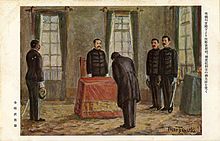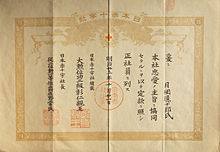Sano tsunetami

Sano Tsunetami ( Japanese 佐野 常 民 ; * December 28, 1822 in Hayatsue, Saga-gun , Hizen Province ; † December 12, 1902 in Tokyo ) was a Japanese politician and founder of the Japanese Red Cross Society ( 日本 赤 十字 社 , Nippon Sekijūjisha ) .
Life
Sano was born in the village of Hayatsue des Fiefdom Saga (now part of the city of Saga ) as the fifth son of the low-ranking samurai Shimomura Saburōzaemon and adopted in 1831 by the doctor Sano Tsuneyoshi. Three years later he first attended the domain school. In 1837 he accompanied his father to Edo , where he dealt with Confucian studies under the renowned Koga Dōan . In 1839 he returned to Saga and received a. a. a medical education. Even after his marriage in 1842 he continued his studies, in 1846 with leading representatives of 'Hollandkunde' ( Rangaku ) such as the doctor Hirose Genkyō ( 広 瀬 元 恭 , 1821–1870) in Kyoto and from 1848 with Ogata Kōan in the famous' Teki- School '( Tekijuku ) in Osaka and the surgical pioneer Hanaoka Seishū in the province of Kii . In 1849 he switched to the Dutch scholar Itō Gemboku in Edo, who is also known throughout the country . Here he was also strongly influenced by Totsuka Seikai , who was once trained by Philipp Franz von Siebold . In 1851 Sano opened his own school in Nagasaki, but in 1853 the sovereign of Saga, Nabeshima Naomasa, gave him a job.
Sano's liege lord was one of those regional rulers who had developed a keen interest in western science and technology. When the government founded the Nagasaki Naval Training Center ( 長崎 海軍 伝 習 所 , Nagasaki kaigun denshūjo ) in 1858 in order to build up a modern fleet through the purchase and operation of Dutch ships, Sano and 17 other companions of the feudal saga belonged to the first generation of students. At his instigation, they began in Saga, which was responsible for the safety of the waters around Nagasaki with the neighboring fiefdom of Fukuoka , with the construction of a steamship , which in 1865 was called Ryōfūmaru ( 凌風 丸 , roughly equivalent to 'wind surpassing') in operation was taken.
In 1867, Sano moved to Europe, where he first heard of the International Red Cross at the World Exhibition in Paris . In the Netherlands he placed an order for a warship designed screw steamer Nisshin ( 日 進 ) and returned to Japan after inspecting the industry, shipbuilding and military of several countries.
After the Meiji reform , he was involved in building up the Imperial Navy . In 1873 he was sent to the World Exhibition in Vienna. Alexander von Siebold , the eldest son of the famous Japanese researcher Philipp Franz von Siebold , acted as interpreter .
In 1875 Sano became a member of the Japanese State Council ( Genrōin ). In 1877 the samurai of Satsuma Province rose up against the new government ( Satsuma Rebellion ). Sano's idea of providing help to injured opponents also met with incomprehension and strong resistance in government circles. But when he turned directly to Prince Arisugawa Taruhito , who was leading the imperial troops, he made sure that Sano and his fellow Senate, Ogyū Yuzuru, obtained permission to found the Philanthropic Society ( 博愛 社 , Hakuaisha ) in 1877. received.
From 1880 to 81 Sano worked as finance minister, after which he took over the chairmanship of the State Council. In 1886 he founded the Philanthropic Hospital ( Hakuaisha byōin ) in Tokyo. In 1887 the Philanthropic Society was renamed the Japanese Red Cross Society ( Nippon Sekijūjisha ). In September of that year, Sano arranged to join the International Red Cross as its first president . In 1894, during the Sino-Japanese War and in 1900 on the occasion of the Boxer Rebellion, the company was first active outside the country.
In 1895 Sano was made a count ( hakushaku ) in recognition of his services . In 1902 he died at his home in Tokyo at the age of 80. Shortly before, he had received the Order of the Rising Sun ( 旭日 章 , Kyokujitsushō ) first class.
Sano's first son Tsunemi ( 常 実 , born 1859), who went to study in Jena in 1880 , died there not long after his arrival. Another son, Admiral Sano Tsuneha ( 常 羽 , 1871-1956), played an important role in founding the Japanese scout movement ( ボ ー イ ス カ ウ ト 日本 連 盟 , Bōisukauto Nippon renmei ).
literature
- Yoshikawa, Ryuko: 'Nisseki no soshisha Sano Tsunetami. Tokyo: Yoshikawa Kobunkan, 2001 ( 吉川龍 子 『日 赤 の 創始 者 佐野 常 民』 、 吉川弘 文 館 ).
- Asahi, Keiko: Sano Tsunetami - kindai-kokka no paionia. In: W. Michel / Y.Torii / M.Kawashima (ed.): Kyūshū no rangaku - ekkyō to kōryū. Kyoto: Shinbunkaku Shuppan, 2009, 289-296 ( 朝日恵子「佐野常民-近代国家のパイオニア」ヴォルフガング·ミヒェル·鳥井裕美子·川嶌眞人共編「九州の蘭学-越境と交流」思文閣出版. ).
Web links
Individual evidence
- ↑ From: Peter Panzer and Sven Saaler: Japanese impressions of an imperial envoy. Karl von Eisendecher in Japan during the Meiji period. Munich 2007.
| personal data | |
|---|---|
| SURNAME | Sano, tsunetami |
| ALTERNATIVE NAMES | 佐野 常 民 (Japanese) |
| BRIEF DESCRIPTION | Japanese politician, founder of the Japanese Red Cross Society |
| DATE OF BIRTH | December 28, 1822 |
| PLACE OF BIRTH | Hayatsue, Saga-gun , Hizen Province |
| DATE OF DEATH | December 12, 1902 |
| Place of death | Tokyo , Japan |


